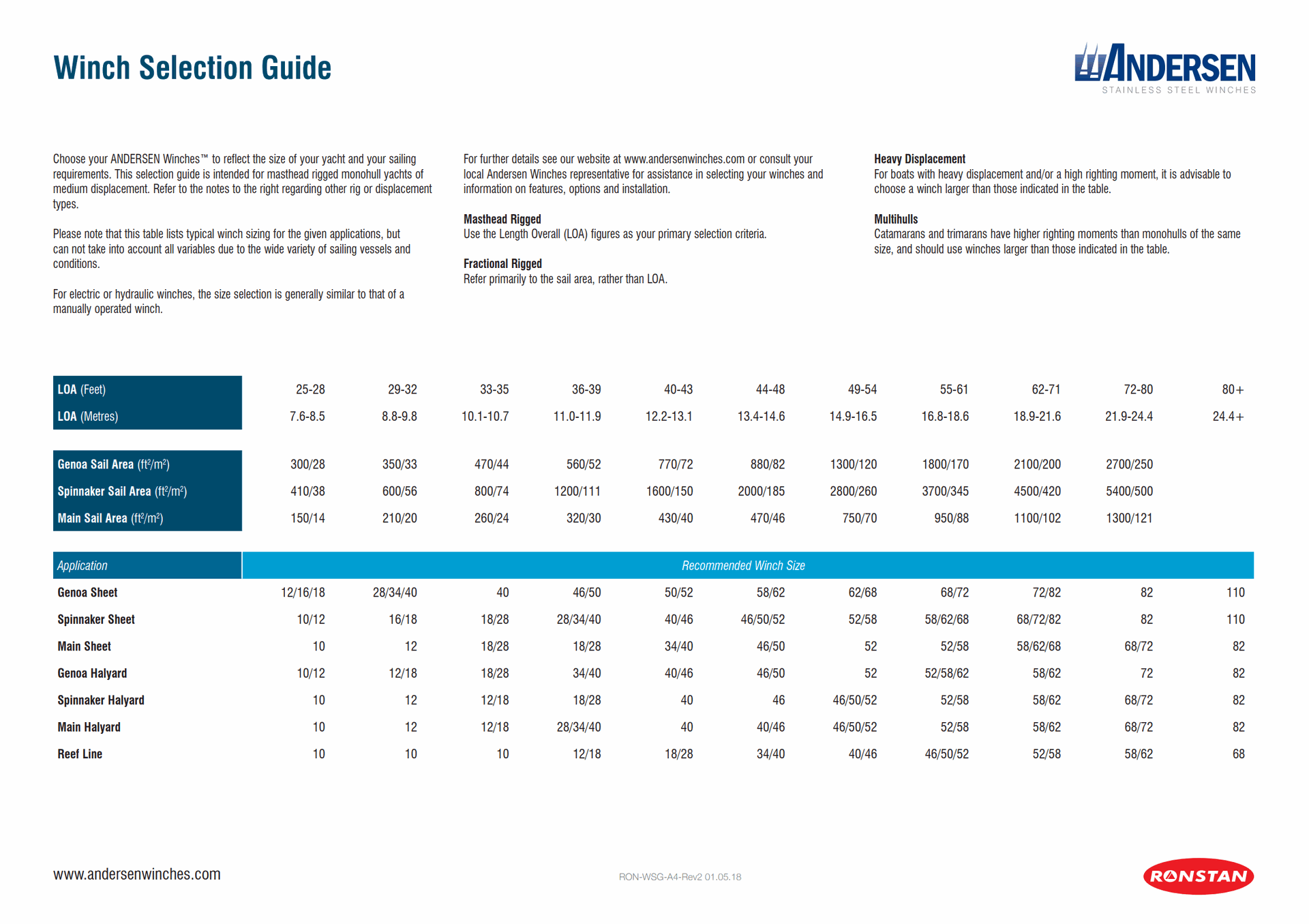Andersen winches are a big name in the boating business. Designed and manufactured in Denmark, Andersen Winch has earned a reputation for building high quality, reliable sailing winch that can last a lifetime.
Are you a sailor who is looking to replace your winch? In this blog we will explain the key variables and challenges involved in selecting the right one.
First we should take a quick look at the different types of sailing winches onboard.
Sailing Winch applications
- Primary / Genoa sheet – as the name suggests this is normally the biggest winch onboard because large upwind genoas are the most highly loaded sail onboard and genoa sheets are normally 1:1. If you have a self-tacking jib with a 2:1 purchase, this would allow the primary winch to be smaller.
- Spinnaker sheet - will generally be smaller than the primaries, as downwind loads are significantly less than upwind loads.
- Mainsheet - Often, mainsheet systems are split (port / starboard) which spreads the load between two winches. In addition, mainsheet systems normally include a purchase system, which reduces the line load further.
- Halyard – Loads do vary between the different halyards and the genoa halyard is generally the highest loaded, followed by the main and then the downwind spinnaker. With coach roof mounted halyard winches it is sensible to size your halyard winches to the highest load; halyard layouts can come and go but it is likely that your Andersen winch will be there for a lifetime! On older, bigger boats with dedicated halyard winches, some optimisation is possible.
- Runner – designed to oppose the upwind load in the forestay and keep the genoa luff straight, they are relatively highly loaded. However, like the mainsheet, the runner always has a minimum of a 2:1 purchase and so line load on the winch is significantly less. Runner winches will often be a similar size to the mainsheet winches.
- Reef – a dedicated reef winch will generally be the smallest winch onboard
Andersen winch selection guide
Tall / short, fat / thin, heavy / light….. one hull or two ….. like humans, boats come in many different shapes and sizes! All manufacturers offer advice on winch sizing but there are so many different variables involved that you have to remember that these are just generalised guides.
The key is to assess where your boat fits in the tall / short, fat / thin…. spectrum and where that sits relative to the manufacturer’s assumptions.
Andersen use two primary selection variables: Length Overall (LOA) and sail area, based on a “masthead rigged monohull of medium displacement”. Sail size obviously has a direct impact on loads and so you need to calculate your sail areas. For guidance on how to calculate your sail areas, see our detailed blog here.
For a given boat length, Andersen will have used average rig geometry data, for their “standard” boat type, to come up with maximum sail areas and then make recommendations for an appropriate winch size for each of the main winch applications.
However, even having made these assumptions, Andersen can still only offer a range of possible Andersen Winch sizes. For example; a Spinnaker winch on a 37ft “masthead rigged monohull of medium displacement” could have anything from a size 28 to 34 to a 40. This is a range of +/- 20% for a boat of the same length, rig geometry and displacement!
So which sailing winch should you select?
As we can clearly see, manufacturer selection guides are built on a range of assumptions and the sheer quantity and variety of boat sizes / systems / setups makes it almost impossible for a boat owner to come up with their own definitive selection. So where does that leave you, from a practical perspective?
Thankfully, the vast majority of boat owners will have existing winches onboard and the default position, assuming new winches are required, is to replace with the same size/brand of winch. If you are switching brands, then the starting position is to switch out to a winch of equivalent size and power.
The industry wide, winch naming convention makes that relatively simple because the number of the winch size generally relates to the maximum power ratio of the winch. Power is a function of gearing ratio and drum diameter and whilst there are subtle differences between the gear transitions on 2-3 speed winches, ultimately a Lewmar 40 has the same max power as an Andersen 40.
The final consideration before buying your winch is to ask yourself the question: “do I have enough power”, and consider going up one winch size. There are a number of reasons you might want to consider upgrading the power of your winches. For example: age is catching up with you, you have a particularly light crew, you want to sail short-handed offshore or you are looking to increase your sail area.
Conclusion on Andersen Winch
At the end of the day there are too many variables involved to simplify into a definitive winch selection guide. Luckily this is not a major issue as you normally have a clear, existing basis for your decision. However, if you are embarking on an ambitious refit or new-build project and have to start from scratch – the only real answer is to speak to an expert. He/she will look at all the factors involved and make a recommendation based on the physical yacht parameters plus your sailing style and crew capabilities.
If you have any questions about Andersen winches, please feel free to email us at [email protected], or click the link below to see our full range:



Andersen Winch - making the right choice